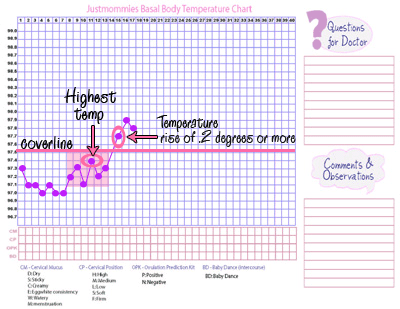Basics Fertility Charting – How do I know when I have ovulated?
{YBA} BBT charting is one way to determine your fertile days and pinpoint when you have ovulated. Temperature charting doesn’t tell you when you will ovulate though. It is not necessarily the best way to predict ovulation because you can’t determine when ovulation has occurred until after it happens.
So why keep a chart then? A bbt chart might not tell you exactly when you will ovulate but it is one way to confirm when and if ovulation has taken place. If you have a biphasic chart, you should be able to tell when ovulation has taken place relatively easily just by looking at your temperatures.
Here is How to Tell You Have Ovulated
Your Temperature Goes up After Ovulation
Once you ovulate your temperature will rise, usually dramatically but not always. Most women’s temperature increases by about .4 degrees or more after they ovulate. (It should increase by at least .2 degrees after ovulation.) Your temperature increases because of progesterone production.
Your corpus luteum which housed your egg before you ovulated produces estrogen and progesterone. Progesterone is what helps to create a thick nutrient rich uterine lining in preparation for implantation. It also causes your body to have a higher resting temperature. Once you ovulate your temperatures should continue to stay higher because your progesterone levels are higher after ovulation.
You Should See Three Days of Sustained Higher Temperatures
Your temperature not only needs to go up to confirm ovulation, it needs to stay up. Once you have seen three days of a sustained temperature rise, you can safely say you have ovulated. It doesn’t matter if your temps are consecutively increasing. For example, your temp could increase by .6 degrees right after you ovulate but the following day your temp might drop by .2 degrees. That is okay. It is still higher than it was before you ovulated and indicates that you are making more progesterone.
Your Cervical Mucous Will Dry Up
Right before you ovulate your body begins producing very fertile cervical mucous. It is egg-white and slippery. This type of mucous helps to transport the sperm up to your awaiting egg. The last day that you see fertile cervical mucous is called your peak day. This is considered your last and most fertile day.
Once you ovulate, your cervical mucous should begin to dry up fairly quickly. When you start to feel dry, you are most likely no longer fertile. Ovulation has probably already taken place. You will want to see four consecutive dry days to verify that you are no longer fertile and that ovulation has already taken place.
Once you have seen a shift in your temperature and your cervical mucous dries up, you can assume that you have ovulated and are no longer fertile.


